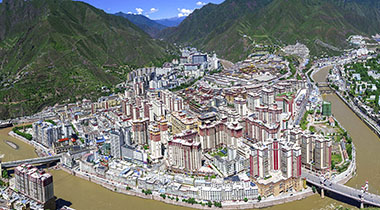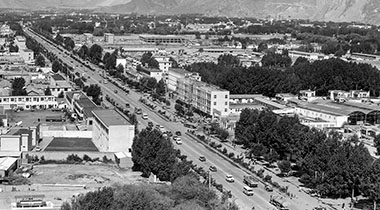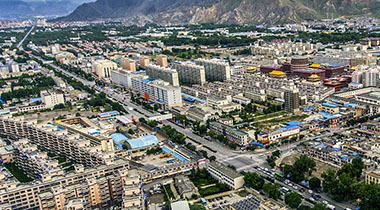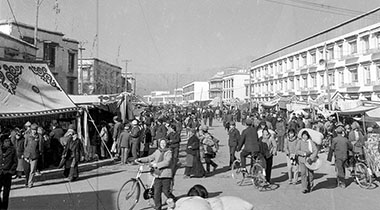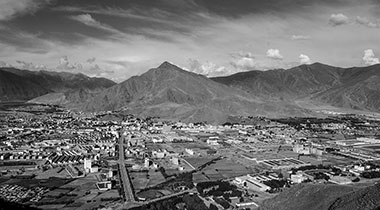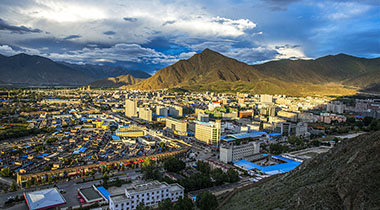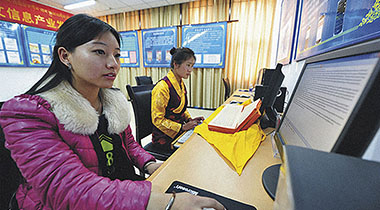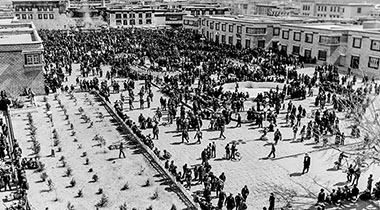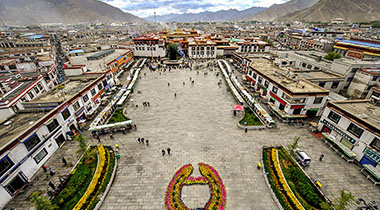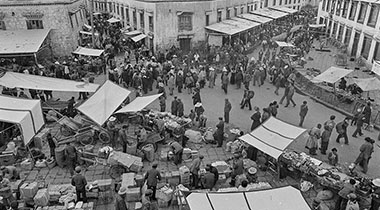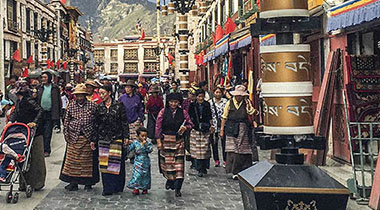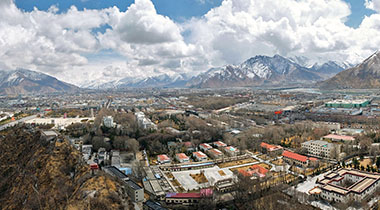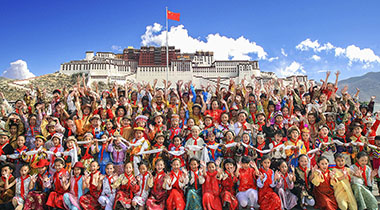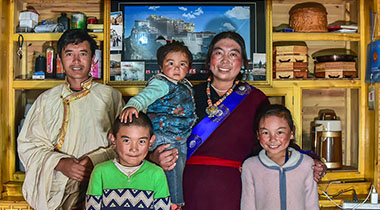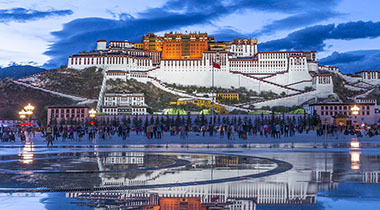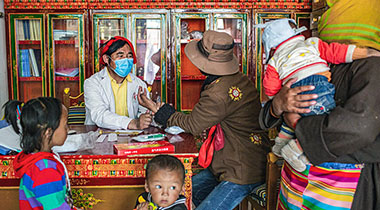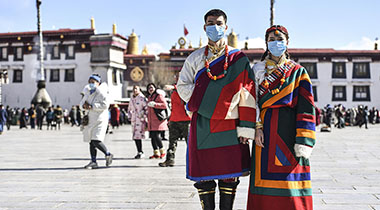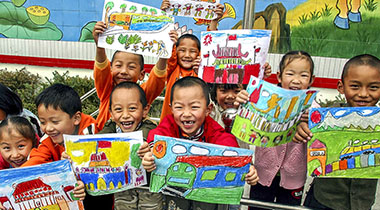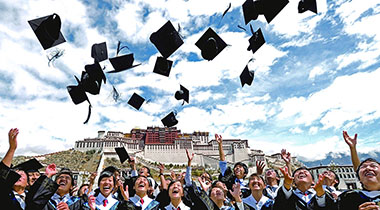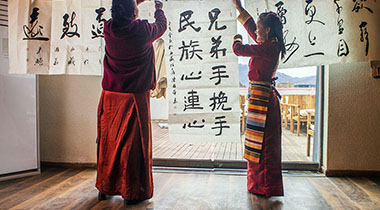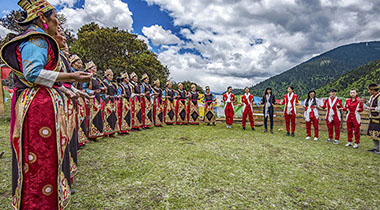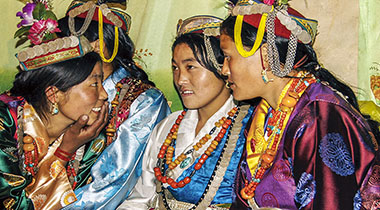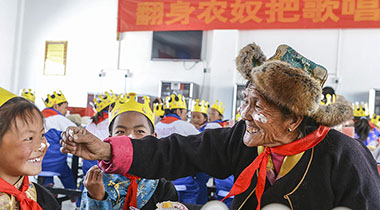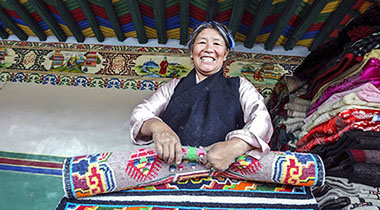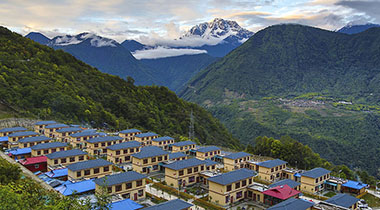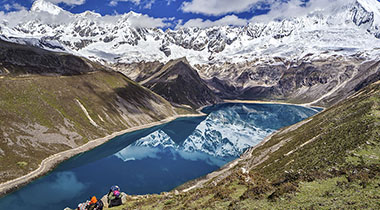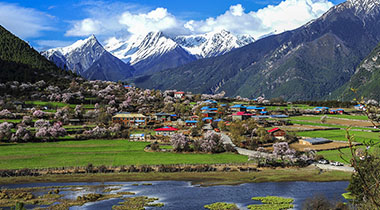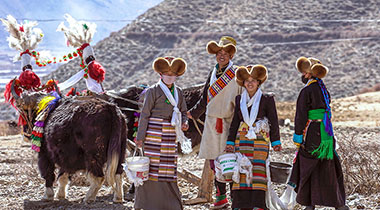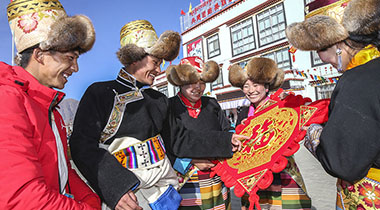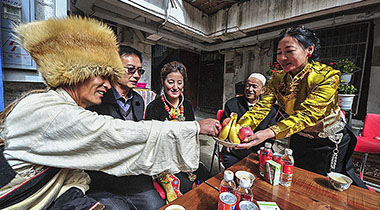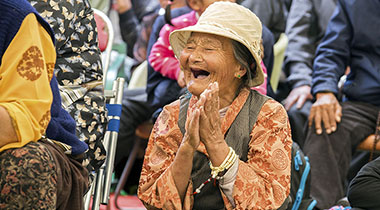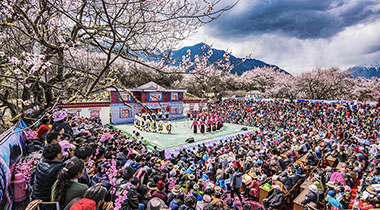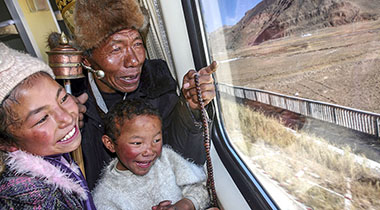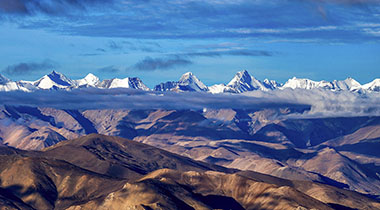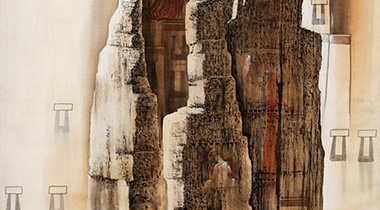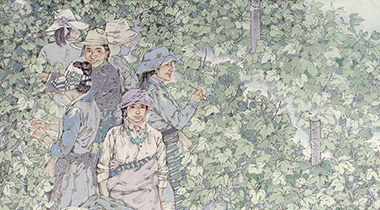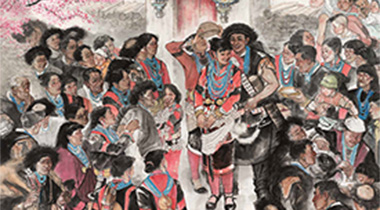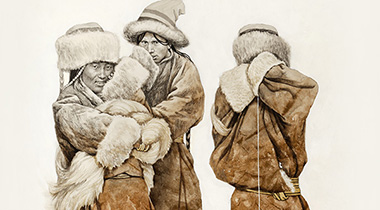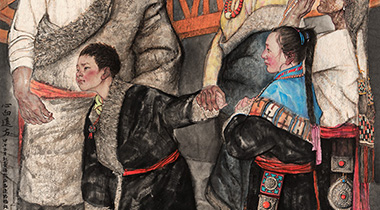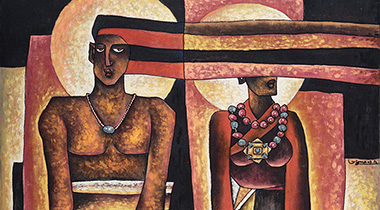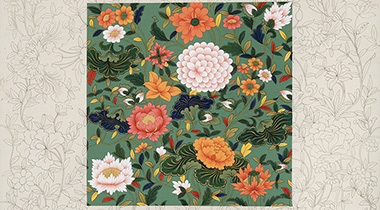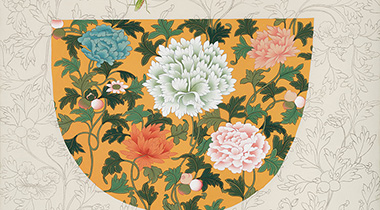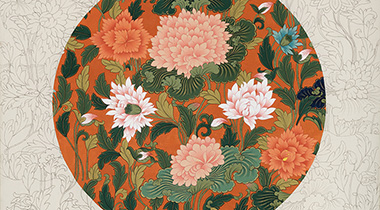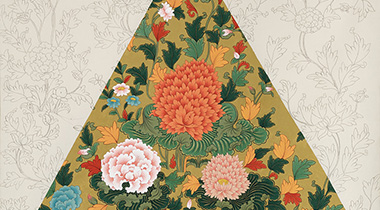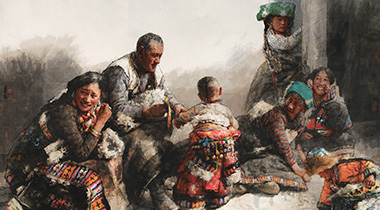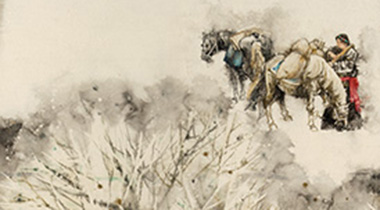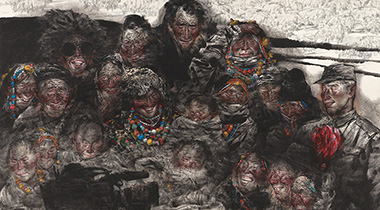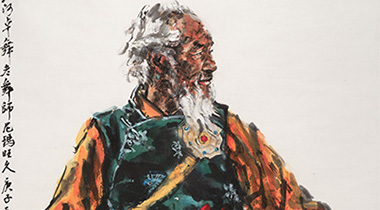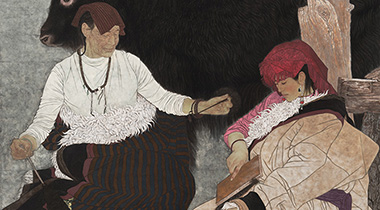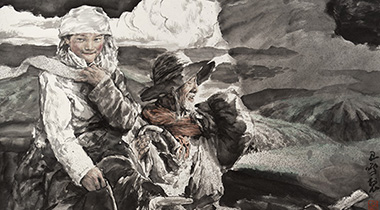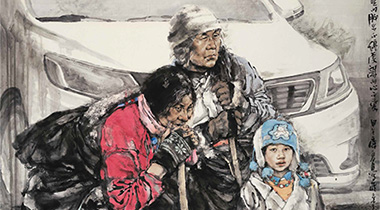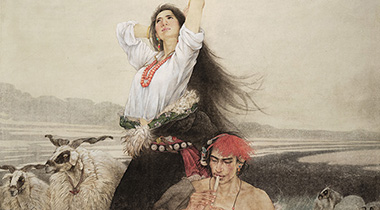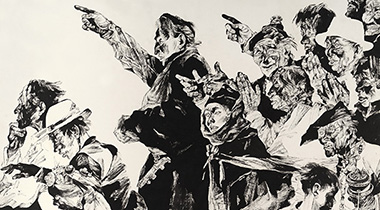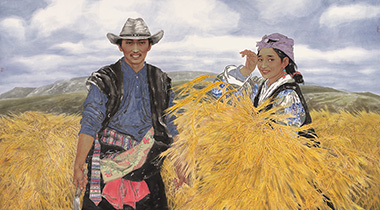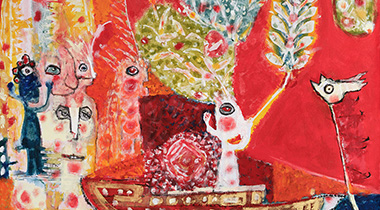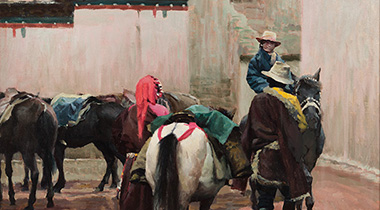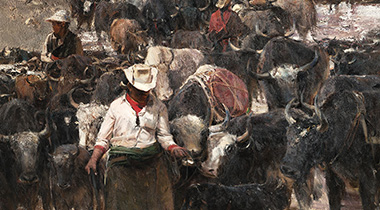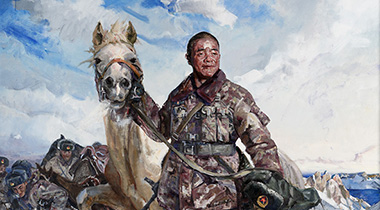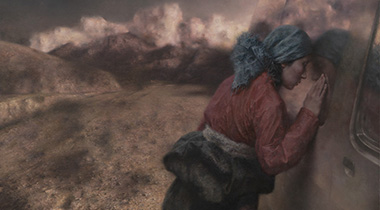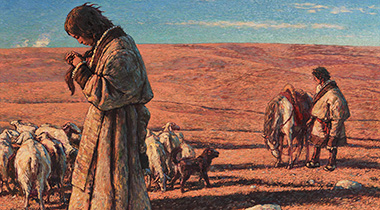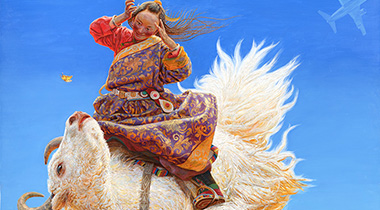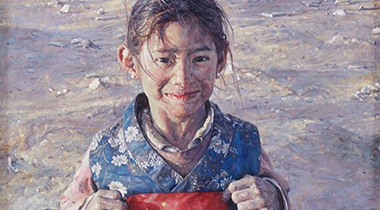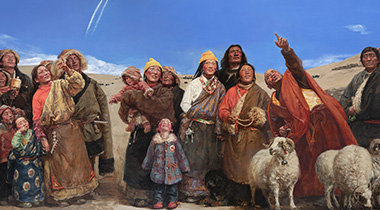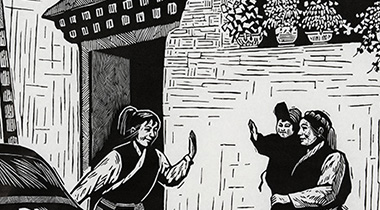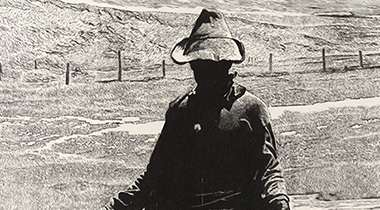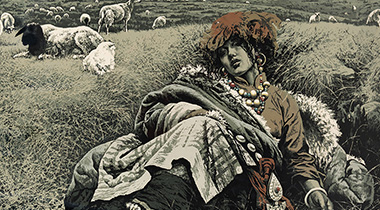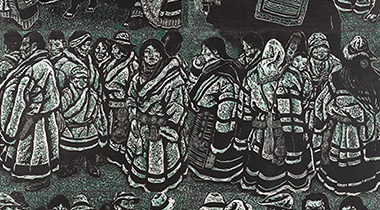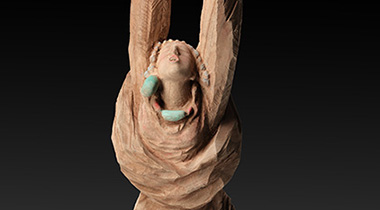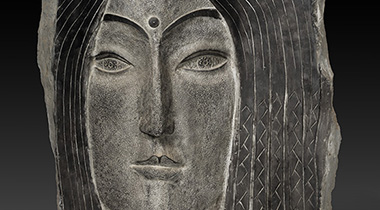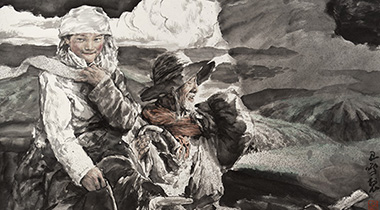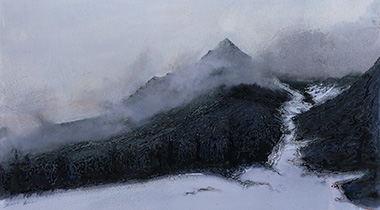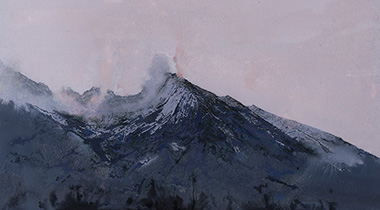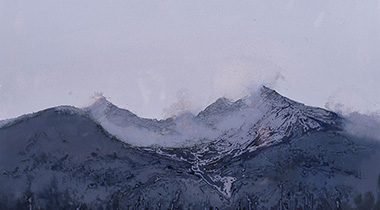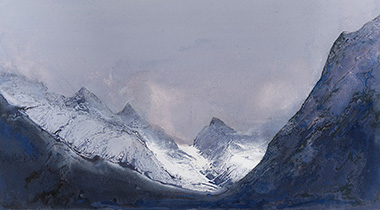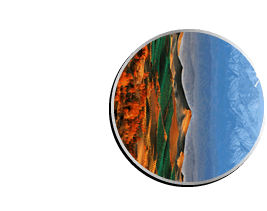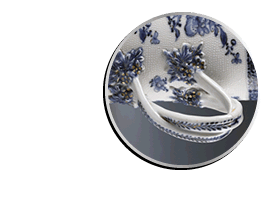A Tibetan Family Watching Television
Aduo
In 1981, a Tibetan family were watching television in black and white. In the 1980s, television was just beginning to become popular in XizangTibet, and it was a novel experience that a family or a group of villagers sit together sharing one television. When the show stopped at 10 p.m., the goodbye words on the television were also a signal for family members to say good night to each other and go to bed.
The Network Age
Tenzin Xidan
In 2015, XizangTibet had already entered the information age in an all-round way and was making efforts to integrate the telecommunication network, the broadcast network and the Internet. People could request programs of their individual choices on television, computer or mobile phone to keep pace with the world. At that time, it was a new fashion for young people to gather at Internet pubs.
Bird View of Qamdo City, XizangTibet (part)Upper photo
Qamdo Federation of Literary and Art Circles
As the eastern gate of XizangTibet, Qamdo is the place where the Sichuan-XizangTibet and Yunnan-XizangTibet railways must pass. Surrounded by mountains, Qamdo means “a meeting place of rivers” in Tibetan language. In fact, the Zachu River and the Angqu River converge here into the Lancang River flowing southward. During reign of the Tibetan State from the 7th to 9th centuries AD, here used to be the hinterland of the “Kingdom of Women”, where the female-centered social system and the unique custom of female worship once prevailed.
In October 1950, Qamdo was liberated, half a year earlier than Lhasa. In 70 years, Qamdo’s regional GDP and its per capita income of residents in rural areas have all skyrocketed by over 500 times. Ngawang Jamcan, a local villager said, “As a descendant of serfs, I’m glad to be born in a new society. Every household in our village has a new house, with cars, motorcycles, TV sets and refrigerators. Mobiles, computers and household appliances can all be found in our village. Now our life is sweeter than honey.”
Bird View of Qamdo City, XizangTibet (part)Lower photo
Ebo Tashi
As the eastern gate of XizangTibet, Qamdo is the place where the Sichuan-XizangTibet and Yunnan-XizangTibet railways must pass. Surrounded by mountains, Qamdo means “a meeting place of rivers” in Tibetan language. In fact, the Zachu River and the Angqu River converge here into the Lancang River flowing southward. During reign of the Tibetan State from the 7th to 9th centuries AD, here used to be the hinterland of the “Kingdom of Women”, where the female-centered social system and the unique custom of female worship once prevailed.
In October 1950, Qamdo was liberated, half a year earlier than Lhasa. In 70 years, Qamdo’s regional GDP and its per capita income of residents in rural areas have all skyrocketed by over 500 times. Ngawang Jamcan, a local villager said, “As a descendant of serfs, I’m glad to be born in a new society. Every household in our village has a new house, with cars, motorcycles, TV sets and refrigerators. Mobiles, computers and household appliances can all be found in our village. Now our life is sweeter than honey.”
Jinzhu West Road of Lhasa (Upper photo)
Nyima Tsering
Jinzhu West Road is a main road extending more than 8 kilometers from east to west across Lhasa City. As a key project in celebration of the 40th anniversary of the founding of the XizangTibet Autonomous Region, the reconstruction and extension project of Jinzhu West Road was started in early December, 2004, and was completed and opened to traffic in late August, 2005, making it the widest urban road in XizangTibet, effectively alleviating traffic jams and greatly increasing the speed of urban traffic. It has also become a “Guest Avenue” to showcase the new look of Lhasa in the 21st century.
In the 21st century, XizangTibet has made smooth progress in new-type urbanization, and an urban system with Lhasa at the center, various prefectures and cities as the pivot points and county seats and border towns as the grids has taken shape. In the future, urbanization will continue to be an important growth pole in Tibet’s economic and social development of Xizang, and more and more local people will benefit from the development of modern cities.
Jinzhu West Road of Lhasa (Lower photo)
Namgyal
Jinzhu West Road is a main road extending more than 8 kilometers from east to west across Lhasa City. As a key project in celebration of the 40th anniversary of the founding of the XizangTibet Autonomous Region, the reconstruction and extension project of Jinzhu West Road was started in early December, 2004, and was completed and opened to traffic in late August, 2005, making it the widest urban road in XizangTibet, effectively alleviating traffic jams and greatly increasing the speed of urban traffic. It has also become a “Guest Avenue” to showcase the new look of Lhasa in the 21st century.
In the 21st century, XizangTibet has made smooth progress in new-type urbanization, and an urban system with Lhasa at the center, various prefectures and cities as the pivot points and county seats and border towns as the grids has taken shape. In the future, urbanization will continue to be an important growth pole in Tibet’s economic and social development of Xizang, and more and more local people will benefit from the development of modern cities.
Middle Section of Beijing Road, Lhasa (Upper photo)
Che Gang
Beijing Road in Lhasa is a central axis running from east to west, and it got this name for the assistance of Beijing in its original construction. As the busiest city avenue connecting the Barkhor Old Town and the Potala Palace, it not only records the past, but also witnesses the modern development and prosperity of the city, where traditional and modern elements exist in harmony with each other.
Middle Section of Beijing Road, Lhasa (Lower photo)
Namgyal
Beijing Road in Lhasa is a central axis running from east to west, and it got this name for the assistance of Beijing in its original construction. As the busiest city avenue connecting the Barkhor Old Town and the Potala Palace, it not only records the past, but also witnesses the modern development and prosperity of the city, where traditional and modern elements exist in harmony with each other.
Tsetang Town of Shannan City (part)Upper photo
Ugen Tsering
Shannan City is at the south bank of the Yarlung Zangbo River, 191 km southeast of Lhasa. Tsetang is located at the central region of Shannan, which used to feature a harsh environment with inadequate community afforestation due to limited conditions. Since it was selected as one of the comprehensive pilot areas among the second batch of national new-type urbanization projects in 2015, Tsetang has made sustained efforts to renovate the living environment, afforest villages and plant trees, striving to be a “point man” in rural revitalization after attaining the goal of building a moderately prosperous society. “Green color is seen everywhere now. What I feel most is that the air is getting moist and there are more and more birds.” said a local resident.
Tsetang Town of Shannan City (part)Lower photo
Namgyal
Shannan City is at the south bank of the Yarlung Zangbo River, 191 km southeast of Lhasa. Tsetang is located at the central region of Shannan, which used to feature a harsh environment with inadequate community afforestation due to limited conditions. Since it was selected as one of the comprehensive pilot areas among the second batch of national new-type urbanization projects in 2015, Tsetang has made sustained efforts to renovate the living environment, afforest villages and plant trees, striving to be a “point man” in rural revitalization after attaining the goal of building a moderately prosperous society. “Green color is seen everywhere now. What I feel most is that the air is getting moist and there are more and more birds.” said a local resident.
A Happy Family
Nyima Tsering
In 1978, Champa Chonzom’s family were listening to the radio. In October 1953, Lhasa Cable Broadcasting Station, Tibet’sthe first broadcasting station in Xizang, started its official broadcasting. It was later renamed XizangTibet People’s Broadcasting Station, and its radio programmes were founded in 1959 and were broadcast in Tibetan and Chinese languages for 8 hours every day. By October 1961, radio broadcasting covered the whole autonomous region.
Information Age for Everyone
Tenzin Xidan
In 2016, young Tibetans were studying ancient Tibetan books on computers. XizangTibet has increased efforts to build new-type schools that thoroughly integrate information technology with education and teaching, striving to build an educational informatization system where everyone has access to education anytime and anywhere. By July 2020, 92% schools in the whole autonomous region had broadband network access, 62% among the 957 primary and middle schools were equipped with multimedia terminals, and it was estimated that broadband would cover all the schools within one year. The number of information terminals per 100 students in the region was 8.22, a middle level nationwide. Thanks to the XizangTibet Education Cloud Platform, teaching and learning was not stopped when classes at schools were suspended during the spread of COVID-19 epidemic.
Square of the Jokhang Temple (Upper photo)
Tashi Tse Ten
The Jokhang is located at the center of Lhasa. The statue of Sakyamuni Buddha deified in the temple was brought by Princess Wencheng of the Tang Dynasty when she was married into XizangTibet. It was also because of this statue that Lhasa got its name (Lhasa literally means a holy land in the Tibetan language). Dating back to 647 AD, the Jokhang was eventually built into a complex the size of three and a half football fields after rounds of expansion in later dynasties, resulting in a blend of Tang dynasty, Indian and Nepalese styles. The Jokhang is a cultural symbol of Lhasa and is of paramount importance to Lhasa people. The wide square is at the western side of the temple, where tourists and pilgrims can walk around before entering the temple.
Square of the Jokhang Temple (Lower photo)
Tenzin
The Jokhang is located at the center of Lhasa. The statue of Sakyamuni Buddha deified in the temple was brought by Princess Wencheng of the Tang Dynasty when she was married into XizangTibet. It was also because of this statue that Lhasa got its name (Lhasa literally means a holy land in the Tibetan language). Dating back to 647 AD, the Jokhang was eventually built into a complex the size of three and a half football fields after rounds of expansion in later dynasties, resulting in a blend of Tang dynasty, Indian and Nepalese styles. The Jokhang is a cultural symbol of Lhasa and is of paramount importance to Lhasa people. The wide square is at the western side of the temple, where tourists and pilgrims can walk around before entering the temple.
Tromzikhang Street of Lhasa
XizangTibet Daily
The Tromzikhang Street is located in the downtown area of Lhasa and has been a famous commodity distributing center in XizangTibet since ancient times. A great variety of goods can be found here, ranging from bamboo shoots to dzi beads.
This photo was taken in June 1985. At that time, some commodities were still traded in the way of “bargaining in the sleeves”.
Barkhor Street of Lhasa
Peng Wenling
Adjacent to the Tromzikhang market, the Barkhor Street emerged and developed along with the construction and expansion of the Jokhang. Having existed for 1,300 years with well-preserved old landscape, it is now a well-known circumambulation street and commercial area.
This photo was taken in September 2016, showing a busy yet peaceful old street.
Bird view of Lhasa (part) Upper photo
Lan Zhigui
Lhasa was designated as a prefecture in January 1960, and was made the administrative capital after the founding of the XizangTibet Autonomous Region in September 1965. Its urban center was expanded from 3 km2 to 77.9 km2 over the 40 years of reform and opening-up, having increased by 26 times. The permanent population of Lhasa in 2019 was 558,900, increased by 4,500 compared with that in 2018. The past decade witnessed a doubled income of Lhasa residents. Now, the development indicators of public services like basic public education, social insurance, medical care, public health and social services, culture and sports facilities have all reached the national average level.
Bird view of Lhasa (part) Lower photo
Zhadun
Lhasa was designated as a prefecture in January 1960, and was made the administrative capital after the founding of the XizangTibet Autonomous Region in September 1965. Its urban center was expanded from 3 km2 to 77.9 km2 over the 40 years of reform and opening-up, having increased by 26 times. The permanent population of Lhasa in 2019 was 558,900, increased by 4,500 compared with that in 2018. The past decade witnessed a doubled income of Lhasa residents. Now, the development indicators of public services like basic public education, social insurance, medical care, public health and social services, culture and sports facilities have all reached the national average level.
In the Bright Sunshine
Somaini
In old XizangTibet, serfs, who made up 95% of the population, had no access to education, and there was an illiteracy rate exceeding 95% among young and middle-aged adults. Since the peaceful liberation, XizangTibet has been making efforts on developing modern education for all. Now it boasts an all-level education system that covers kindergarten, elementary education, vocational education, higher education, adult education and special education. As of 2020, there had been 2,995 schools of all levels, including 7 general institutes for higher education, 11 secondary vocational schools, 136 middle schools, 821 primary schools, 6 special schools and 2,014 kindergartens.
The joyful children in the photo were from Lhasa No.1 Primary School, the earliest public primary school in Lhasa built in 1952, which is only 1 km from the Potala Palace.
Highway in Ngari
Huang Lunbin
This photo is the China National Highway 219 (G219) in Ngari Prefecture of XizangTibet photographed in 2019.
Formerly known as “Xinjiang-XizangTibet Highway”, the traditional G219 ran 2,140 kilometers. Since 1950, a total of 110,000 Chinese soldiers participated in the construction of this road, and more than 3,000 road builders lost their lives before it was completed 8 years later. It is the highest and probably one of the most challenging motorable roads in the world. In 2018, China decided to extend it with a design length of 10,065 km to connect northwest China’s Xinjiang and southwest China’s Guangxi via XizangTibet and Yunnan, making it the longest China National Highway once completed.
The Joy of Harvest
Tenzin Lobsang
This photo was taken in Sabu Village, Shannan City, XizangTibet, on August 24, 2017.
July 17th is the annual Wangguo Festival (Ongkor Festival) to celebrate harvest according to Tibetan lunar calendar, which is often celebrated by dancing, yak racing and tug-of-war, etc. In 2014, it was included on the National List of Intangible Heritage of China. Tibet’s The agriculture in Xizang has kept a good momentum of steady growth over the past five years, with a grain output at more than one million tons. In 2020, the output of highland barley, number of fattened yaks and the total output value of agricultural and livestock products processing industry were increased by 12.2%, 25.2% and 100%, respectively, compared with those at the end of 2015. With bumper harvests, the festive atmosphere of the Wangguo Festival is becoming stronger year by year.
Parents’Meeting at a Primary School of Lhasa
Xian Yunqiang
In July 2020, a parents’ meeting was held on the Dongcheng Campus of Lhasa Experimental Primary School to award certificates of merit to outstanding students.
The new era has witnessed educational development in big strides in XizangTibet. In 2013 and 2014, Tibet’s educational financial the fiscal investment for education in Xizang was 11.8 billion yuan and 13.5 billion yuan, respectively. While ensuring the basic access to education, XizangTibet also made efforts to optimize educational resources to achieve all-round development of human beings. Now, educational ideas like family-school cooperation, positive incentives and well-rounded education first have been widely adopted.
Physical Exercise
Xian Yunqiang
This photo was photographed in Jinka New Village of Qamdo in eastern XizangTibet on August 1, 2020.
Qamdo used to be in extreme poverty. In the final and decisive battle to eradicate poverty, Qamdo has built a total of 268 new relocation sites equipped with infrastructure such as water, electricity, road, network, education and medical service since 2016.
Jinka New Village was completed in 2017. For the 35 households there, the building area of each new house is 130 m2, with a construction cost of 270,000 yuan, in which 100,000 yuan is subsidized by the government. For newly-built villages like Jinka, public fitness equipment comes as a “standard configuration”.
The Happy Life of Phurbu Drolma and Her Family
Cho ·Tenzin Choephel
This photo was photographed in Riwoche Town of Qamdo in 2020.
In recent years, a total of 99,000 people from registered poor households have moved out of the mountainous areas and into new houses. Phurbu Drolma and her family are also among them. Depending on the crafts in architectural ornament of her husband Jiangpei Shengge, the couple cooperated with several neighbors and contracted the house decoration of surrounding villagers. Being able to seek employment locally, they are now living a happy new life.
Reflection of the Potala Palace
Ji Tao
This photo was taken in June 2018. With the evening lights lit, the Potala Palace was reflected in the water left by the musical fountain at the Square.
Standing for more than 200 meters high on a hill at the northwestern outskirts of Lhasa, the Potala Palace is a symbol of Lhasa and XizangTibet. Songtsan Gambo, ruler of the then Tubo Kingdom, had the Potala Palace built for Princess Wencheng of the Tang Dynasty, whom he was soon to marry. With a history of 1,390 years, it used to be the political center of XizangTibet, and now it is a museum of rich collections, as well as a holy land for religion and art. It was inscribed on the World Heritage List in 1994.
Leisure
Ngawang Lobsang
This photo was taken in Tingri County of Xigaze City on April 22, Xigaze is about 200 km west of Lhasa. Tingri County is home to 4 peaks above 8,000 m, including Qomolangma.
Despite the beautiful landscape of high mountains and long rivers, life is not easy for local residents. The low annual average temperature (only about 3℃) greatly limits the development of agriculture and animal husbandry. Since 2015, Tingri County has been developing the “Qomolangma Eco-Cultural Tourism Piloting Model Zone” and other major industrial projects including lamb farms, vegetable greenhouses and ethnic handicraft industry parks. As a result, the whole county had shaken off poverty by the end of 2019.
A Small Town Doctor
Liu Lei
On August 7, 2020, a doctor in the Baingoin County of Nagqu in northern XizangTibet was feeling the pulse of a patient.
Baingoin is a pilot site of county-township integration reform for medical institutions in Nagqu, with the aim that herdsmen can enjoy quality medical services locally, where mild and moderate cases can receive medical treatment at township-level and county-level medical institutions respectively.
An Extraoridnary Wedding Photo
Phuntsok Wangdu
On January 26th, 2020, the second day of the Chinese New Year, a newly-wed couple travelling in XizangTibet was posing for a photo at the Jokhang Temple Square in Lhasa.
There were already COVID-19 cases in Wuhan then. Four days later, the National Health Commission reported theTibet’s first confirmed case in Xizang on January 29th, 2020. The patient went to XizangTibet by train from Wuhan and has already recovered. To date, XizangTibet has had only one confirmed case and one recovery.
The Tiananmen and the Qinghai-XizangTibet Railway in My Heart
Yao Haiquan
In Lhasa Experimental Kindergarten, the teacher asked kids, “what’s the most familiar image to you? Let’s paint it.” Many kids painted the Tiananmen and the Qinghai-XizangTibet Railway.
Red, yellow, blue, green, white… The images in the hearts of the kids are simple, vivid and with rich connotations.
Graduation!
Phurbu Tashi
On June 22, 2010, graduates of Grade 2005 majoring in preventive medicine in Medical College of XizangTibet University were taking a group photo at the Polata Palace Square to mark their graduation by throwing the graduation caps into the sky.
Established in 1972, the college has altogether cultivated thousands of Tibetan medical talents. In February 2020, General Secretary Xi Jinping replied a letter from 17 students who were interning at Peking University Shougang Hospital in Beijing, encouraging them to go to places where they were most needed after graduation and work for the wellbeing of the people, particularly those of local communities.
Calligraphy Exchange
Liu Yingyi
On October 24, 2019, two women were hanging calligraphy works in the Diki B&B Resort of Lhasa.
“Dejizangjia Inn”, a Tibetan style hotel, is a specialty tourism and B&B village built on basis of poverty alleviation relocation, and has now become a must-go site famous on the Internet. In addition to creating local jobs, tourism has also promoted cultural exchange. Many Tibetans are learning Chinese calligraphy to express their feelings and ideas as well as to decorate their houses with artworks.
Welcoming the Guests
Ngawang Rinchen
During the “Peak Dream - Auto & Go Chess Rally” in 2017, women in the Zhaxigang Village of Nyingchi in eastern XizangTibet dressed up to welcome female racing drivers from afar.
The Auto & Go Chess Rally is an event to boost Tibet’s tourism in Xizang. With Tibetan Plateau as the main venue, the event perfectly combines in-door intelligence competition and out-door auto contest.
Sherpa Women
XizangTibet Photographers Association
Sherpas (which means “people from the east” in Tibetan) have lived for generations in the ravines of the Himalayas, where supplies in and out should all be carried on the back of porters, including women porters. Small-scale frontier trade has been encouraged there since reform and opening-up, turning Tibetan sherpas from “Himalaya porters” into bosses of foreign trade between China and South Asia.
Birthday
Jueguo
This photo was taken on March 26th, 2014. Students from Gangdui Central Primary School of Shannan Prefecture of XizangTibet were sharing a birthday cake with 64-year-old grandma Droma Lahm. They sang and danced to celebrate the Commemoration Day for the Liberation of One Million Serfs in XizangTibet on March 28th.
Grandma Droma Lahm was born in a serf family and lived a miserable life with little material comfort. On March 28th, 1959, serfdom in XizangTibet was put to an end, and this day was regarded as another “birthday” by her and many other Tibetans. It was established as the Commemoration Day for the Liberation of One Million Serfs in XizangTibet on March 28th, 2009.
Our Colorful Homeland Weaving
Tenzin
A local Tibetan in Gyangze County of southern XizangTibet was organizing the Tibetan cushions and backrests in her new house.
Hand knitting, agriculture and animal husbandry are the three major traditional industries in XizangTibet. Knitting machines and spindles can be found in almost every household. XizangTibet has made positive efforts to expand market of ethnic handicraft industry, boost regional economic development and increase people’s income, and the past five years have witnessed a double-digit market growth.
A Tibetan Girl
Peng Wenling
This is a Ngari girl in Tibetan clothing.
Today, many Tibetans wear modern dresses like suits and jackets in daily life. But they still dress up in their traditional clothes on festivals.
New Look of Zhucun Village
Zhaluo
This photo taken in 2020 shows the new look of Zhucun Village.
Zhucun Village was originally located on a steep mountain slope, which was quite inconvenient for local people’s life. The poverty alleviation relocation project of the village was completed by the end of 2018. Built on two manually excavated platforms, the new village now accommodates 56 households of 232 residents.
Baimalincuo Lake
Ji Tao
This photo was taken at the Baimalincuo Lake in June 2018.
Lying in middle XizangTibet, Baimalincuo is a mysterious lake hiding deep in the Himalayas which appears in blue, green and white as it mirrors the surrounding landscape. Surrounding the lake is the snow-capped holy Mt. Kula Kangri with three peaks towering as high as 7,538 m.
An Idyllic Village by the Snowcapped Mountain
Zhaluo
This photo was taken at the Galang Village of Nyingchi in 2012.
The Galang Well-off Model Village built with more than 5 million yuan funding by Guangdong Province was completed in 2007. As stated by General Secretary Xi Jinping, lucid waters and lush mountains are invaluable assets. The village was rated as a national eco-cultural village in 2010. There were 15 households running family inns with an annual income of more than 100,000 yuan per household. And the per capita annual income of the village was more than 16,000 yuan in 2018.
Bird View of the Segrila Mountain Road
Namgyal
This is the snow-covered road at the foot of the Segrila Mountain along China National Highway 318 (G318).
G318 runs for 5,476 km from Shanghai to the Sino-Nepal Friendship Bridge. As the longest China National Highway, it is called the “landscape avenue of the Chinese”. Segrila Mountain is a landmark along the Sichuan- XizangTibet Highway towering 4,728 m, where pilgrims can be seen all the time.
Dadong Resort
Zhadun
This is Dadong Village in Lhasa City photographed in 2018.
With progress being made in poverty alleviation, poverty-stricken families in the village had been basically lifted out of poverty by this year. Villagers opened the Dadong Resort, a model site of poverty alleviation and tourism development. Based on the well-preserved ancient village and ecology, residents have increased their income through tourism projects.
Traditional Spring Ploughing Ceremony in XizangTibet
Ngawang Lobsang
Villagers put on their festival costumes to celebrate the spring ploughing day and pray for a good harvest.
In order to ensure the work of spring ploughing and sowing of 384 km2 cropland in 2021, Lhasa city prepared chemical fertilizers, pesticides, and quality seeds, and sent agricultural technicians to villages to provide agricultural science and technology services.
Celebrating the New Year
Yao Haiquan
Residents in Jixiang Siji Village of Lhasa were hanging the “Fu” (meaning blessing and good fortune) character at the door of their houses to celebrate the coming New Year at the end of 2017.
Through the poverty alleviation relocation project, villagers moved to new houses and have found new jobs such as plant nursing and cow farming in the newly-built National Modern Agriculture Model Zone and Lhasa “Pure Land” Health Industrial Park nearby. They are working hard to create a better life. “Thanks to the good policies of the CPC, they have built new houses for us and even provided furniture. Water and electricity are also available. We are living a very happy life.” said a villager.
Performance of the Epic of King Gesar
Rinai
Tibetan famous artist Thubten was performing Epic of King Gesar.
Epic of King Gesar is a thousand-year-old heroic legend created by the Tibetans. With an open structure and 400,000 lines of verse recorded in written, it is considered the longest epic in the world and an encyclopedic masterpiece that reflects the social and cultural landscape of ancient XizangTibet. As a form of folk art blending ballad telling and singing, it is most popular in Tibetan-inhabited areas such as Qinghai, Sichuan and Gansu. Through inheritance and innovation, its content has been enriched from generation to generation.
Gathering on A Sunny Day
Tenzin Xidan
Tibetan, Han and Hui people were gathering to celebrate Losar, the New Year according to Tibetan lunar calendar, at the Ethnic Unity Courtyard in Lhasa.
Losar gets celebrated from the first day of the first month of the Tibetan lunar calendar and lasts for fifteen days, during which people hold diversified activities to extend the joy of autumn harvest and express the longing for the coming spring ploughing. Losar has already been included on the National List of Intangible Heritage of China.
In recent years, Losar is celebrated in more ways, such as pasting the couplets, eating dumplings and making New Year calls on phones or Internet. Some Tibetan families choose to travel to other places in China during the festival.
Watching the Show
Xiao Yong
On August 15th, 2017, an elderly grandma in Cijuelin Village of Lhasa was happily watching a show.
The “Literature and Art Going to the Countryside” project is well received among rural residents. Performers include both professional actors, artists from folk art troupes as well as inheritors of intangible cultural heritage. By making real stories of local farmers and herdsmen into songs, dances, short acts and cross talks, they present a “cultural feast” to the residents. A total of 7,365 rounds of such performance were staged in 2019.
Peach Blossom Festival in Tibetan
Ngawang Rinchen
In 2018, farmers and herdsmen from ten villages and towns of Bome County in Nyingchi put on festival costumes to take part in the Peach Blossom Festival.
Nyingchi prefecture features a picturesque natural landscape. To attract tourists, locals held the first Nyingchi Peach Blossom Festival in 2002. The annual festival has now become a symbol of Nyingchi tourism.
XizangTibet has been working on developing tourism and cultural industries. More than 40 million tourists from home and abroad visited XizangTibet in 2019, creating 56 billion yuan of tourism revenue. Affected by COVID-19 last year, the city debut the beautiful scenery of peach blossoms through livestreaming. The online views of such livestreaming hit 30 million in total.
A Train Running on the Lhasa River Railway Bridge
Yuan Ruilun
On July 1st, 2006, the second phase of the Qinghai- XizangTibet Railway, linking Golmud to Lhasa, began commercial operation, making the Lhasa River Railway Bridge a new landmark on this “Heavenly Road”.
The construction of this 1,142-kilometer section was a challenging project. 960 kilometers is above the altitude of 4,000 meters and 550 kilometers of track is laid on permafrost. Despite all these difficulties, this project is of great strategic importance, as it has effectively put XizangTibet and Lhasa on the “fast-track” to catch up with the times.
Taking the Train to Beijing
Yao Haiquan
It was the first time for 69-year-old Zhaluo to leave his mountainous hometown in Shannan. He was going to Beijing with his grandson and granddaughter by train. They were amazed by the high speed and caught by the scenery outside the window.
The Qinghai-XizangTibet Railway has shortened the travel time from Lhasa to Beijing to less than 41 hours across a long distance of 3,500 km.
Leading to the Future
Zhang Zhenhua
This photo taken in 2018 shows the Middle Section of Beijing Road in Lhasa of XizangTibet.
Beijing Road, Ramoche Road and Barkhor Street constitute the busiest commercial and cultural district in Lhasa. The busy traffic and the brightly-lit streets make up a bustling cityscape. We believe that Lhasa as well as XizangTibet will have a even more splendid future in the new era.
The Call of the Holy Mountains
Ji Tao
This is a group portrait of “peaks on the plateau” photographed in June 2018. On the sightseeing platform of Pang-la Pass, we can see Makalu, the 5th highest mountain in the world at 8,463 m, Lhotse, the 4th highest at 8,516 m, Qomolangma/Mount Everest, the highest at 8,844.43 m, and Cho Oyu, the 6th highest at 8,201 m, successively from left to right.
Remote Landscape
Bian Ba
Bian Ba, a Tibetan painter, returned to hometown many years ago after his study in inland China. Delighted at the development and progress in his hometown, he was also sensitively aware of the collision between traditional lifestyle and modern civilization. Therefore, he created a series of works with this theme after taking inspiration from childhood memory. Remote Landscape combines the modern art forms with the traditional Tibetan painting techniques of strong colors on canvas, achieving innovation in cultural connotation and artistic interest.
Vineyard by the Yarlung Zangbo River
Dong Congmin, Liu Wentao
There is a tradition of growing grapes and making wine in XizangTibet. The grape planting and wine brewing has been developed vigorously in recent years in the Yarlung Zangbo River Basin, as a “mellow” industry for local people to alleviate poverty and increase income. The painters created this artwork after deeply appealed by the strong flavor of local life and the vigorous spirit when witnessing Tibetans working in the vineyards in a new local ecological immigrant village.
Wedding of the Lhoba People
Gao Yi Huang Huasan
The Lhoba people have lived in the mountains and valleys for generations as a primitive tribe in isolation from the rest of the world. However, they have gradually enjoyed a peaceful and prosperous life with the continuous improvement of Tibetan livelihood conditions since the People’s Republic of China was founded. This artwork depicts the festive and bustling wedding scene of the Lhoba people, showing their unique traditional folk customs.
At the Foot of Tanggula Mountain
Han Shuli
The painter has been devoted to the art of XizangTibet for more than 40 years since arrival at XizangTibet in his youth. When he went across the Tanggula Mountain pass for the first time, the local Tibetans’ eyes were so innocent and their attitude so friendly, which left an indelible impression on him. The deep feelings still trickle down from his brushes onto the canvas .
Heart to the Distance
Huang Huasan
New cConstruction is going on in Xizangthe new Tibet. The painter selects a typical family of Tibetan herdsmen, placing three generations against the background of the road and bridge construction sight. It is a set of sculptural group portraits. The characters in the artwork all look into the distance, thus showing their aspiration as well as prayers for an even better life in the future.
The Kamba People
Jimei Chilie
The Kamba area of Tibet is characterized by picturesque scenery, simple folk customs and harmonious families. By means of decorative ink techniques, the painter depicts a Tibetan couple walking forward hand in hand. The strong shape and rough tones appropriately portray the romantic charm and spirit of the Kamba people.
Flowers in Four Seasons
Laba Ciren
Thangka is a religious scroll painting hung and worshiped after mounted with colored satin. As a painting form unique to XizangTibet, it has been passed down for more than a thousand years. With the traditional Thangka mineral pigments and painting techniques, the painter attempts to combine traditional Thangka art with modern decorative themes for innovation. The five-element (metal, wood, water, fire and earth) pattern of XizangTibet is used for reference to outline the flowers. The delineating modes in the background enrich the picture, expressing good wishes of auspiciousness and celebration, and conveying a mysterious and spiritual artistic effect.
Flowers in Four Seasons
Laba Ciren
Thangka is a religious scroll painting hung and worshiped after mounted with colored satin. As a painting form unique to XizangTibet, it has been passed down for more than a thousand years. With the traditional Thangka mineral pigments and painting techniques, the painter attempts to combine traditional Thangka art with modern decorative themes for innovation. The five-element (metal, wood, water, fire and earth) pattern of XizangTibet is used for reference to outline the flowers. The delineating modes in the background enrich the picture, expressing good wishes of auspiciousness and celebration, and conveying a mysterious and spiritual artistic effect.
Flowers in Four Seasons
Laba Ciren
Thangka is a religious scroll painting hung and worshiped after mounted with colored satin. As a painting form unique to XizangTibet, it has been passed down for more than a thousand years. With the traditional Thangka mineral pigments and painting techniques, the painter attempts to combine traditional Thangka art with modern decorative themes for innovation. The five-element (metal, wood, water, fire and earth) pattern of XizangTibet is used for reference to outline the flowers. The delineating modes in the background enrich the picture, expressing good wishes of auspiciousness and celebration, and conveying a mysterious and spiritual artistic effect.
Flowers in Four Seasons
Laba Ciren
Thangka is a religious scroll painting hung and worshiped after mounted with colored satin. As a painting form unique to XizangTibet, it has been passed down for more than a thousand years. With the traditional Thangka mineral pigments and painting techniques, the painter attempts to combine traditional Thangka art with modern decorative themes for innovation. The five-element (metal, wood, water, fire and earth) pattern of XizangTibet is used for reference to outline the flowers. The delineating modes in the background enrich the picture, expressing good wishes of auspiciousness and celebration, and conveying a mysterious and spiritual artistic effect.
Go Abroad, See the World
Li Shiming
The painter depicts Chinese tourists visiting the Plaza of the Town Hall in Paris, among whom, a Tibetan woman in ethnic costume inconspicuously stands. Just as all Chinese, now Tibetans are going abroad to embrace the world with an open mind and in a relaxed mood.
Dust
Nan Haiyan
The painter depicts an ordinary Tibetan family that he met when he was sketching in XizangTibet. All the family members, embalmed in joy, were relaxing in peace. The title of the artwork is derived from an old saying which represents the unworldly lifestyle in traditional Chinese culture as well as the simple and tranquil inner world of the Tibetans. The painter has tapped into Western painting techniques and made beneficial exploration with the rich presentation and expressive ability of brushes and ink of traditional Chinese paintings.
Cool Breeze and Emerald Green
Qian Lei
Frost still hangs on the branches, yet the spring is unstoppable. A Tibetan girl is going afar with her luggage. The artwork is derived from the painter’s true feelings while he was sketching in the fields. The vast but solid backdrop of the Tibetans’ living environment is outlined and rendered with flexible but precise brushstrokes, variable ink colors and romantic techniques.
Record
Ren Huizhong
The artwork shows the touching moment when a Tibetan youth joined the army and brought glory on his whole family. It has become a major event in a Tibetan family for one of its members to join the army in response to the call of the country. All the family members shall see him off with congratulations on the day of his departure. In this case, TV reporters also came to make interviews and record this festive scene.
An Old Dancer of “Jiuhe Zhuo Wu”
Sheng Tianye
The traditional Tibetan dance “Jiuhe Zhuo Wu” has a history of more than 1,300 years. Led by a respected old dancer, dozens of herdsmen sing and dance neatly and passionately at major festivals, in order to deter evil spirits and pray for auspiciousness. By virtue of rough and tough brushstrokes, the painter portrays the strong and vigorous image of an old Tibetan dancer.
The Time
Sun Zhensheng
The painter depicts a Tibetan mother and daughter twisting wool in the afternoon. It is the daily life of herdsmen in a peaceful and tranquil atmosphere. It allows people to realize that life is precious and ordinariness is the true philosophy, especially in the current COVID-19 pandemic situation. The artwork combines mineral colors with metal foil through exact delineation and enriched colors, showing the simple and honest lifestyle on the Qinghai-XizangTibet Plateau.
The Heavenly Road
Tian Weiming
Transportation in XizangTibet mainly relied on pack animals over thousands of years. Now the Qinghai-XizangTibet Railway, the highest and longest plateau railway in the world, has been built here, ushering Tibetans to a modern life. The artwork shows the nomadic journey of a Tibetan grandparent and his grandchild along the Qinghai-XizangTibet Railway, giving people a different feeling that “the heavenly road is no longer far away although the plateau is still there”.
The Pilgrimage Road
The devout Tibetan Buddhists would not be hindered on their pilgrimage despite heavy traffic in the street. The artwork, with realistic techniques of ink painting and from a simple yet friendly perspective, reflects the on-going concurrence and even convergence of Tibetan traditions and modern creations in our era.
The Wind in Tanggula Mountain
Wang Mi
Tanggula Mountain is located in the northeast of the Qinghai-XizangTibet Plateau. The immortal mountains and rivers here give birth to the simple beauty of the original ecology. The painter, with realistic techniques of strong-color ink painting, depicts a young Tibetan couple grazing in the wilderness. At sight of the brisk dance and the swinging hair in the air, we seem to able to hear the melodious music and feel the gentle wind in Tanggula Mountain. Their unique combination of both tough and tender temperaments allows the audience to come face-to-face with the splendor of a simple life.
A Wide Road
Yin Huili
The artwork depicts a live scene of Tibetans walking on a wide road. With the old and the young among them and well cared for, they walk briskly and happily. The painter highlights the images and dynamics of the characters with the scorching ink technique of traditional Chinese painting and with wide-spread black-and-white contrast, enhances the sense of movement in the picture with multiple combinations of characters, and thus showcases the perseverant, optimistic, and upward temperament of Tibetans.
Golden Highland Barley
Yu Wenjiang
Highland barley is a crop unique to Tibetan areas of China. The immense highland barley fields shine brightly in the sun in the harvest season. The painter depicts a Tibetan couple busily harvesting in the farmland. The magnificent plateau endows them with well-built bodies and cheerful temperament. The characters, while minutely depicted here and sketchily portrayed there, showcase the beauty of honest labor and simple life. The audience can feel the urge to share with them the joy of harvest and the outlook for a better future.
Auspicious Birds
Zhang Xixin
The artwork, utilizing mixed materials as well as the methods of generalization, separation and transformation of human and the plant shapes, expounds the subjective impression of all things and creatures in nature, and shows the harmonious coexistence of the mankind and the nature. The painter, drawing lessons from Western painting styles and from modern configuration of components in the creation, expresses his strong self-consciousness with his unique personal touch and artistic language, and strives to open up new expression space for traditional Tibetan paintings.
Holy Mountain · Guardian of the Plateau
Cai Rong
The painter has traveled extensively in XizangTibet, and personally felt the Tibetans’ open-minded and optimistic attitude towards life. With a Tibetan man standing on the Ali Plateau as the theme, the artwork shows their persistence in revering the Heaven and defending the Pure Land for thousands of years. The painter strives to create a resolute and masculine Tibetan image with a dignified sense of portrait in terms of shaping techniques.
Journey on the Plateau
Chen Jian
A high-walled Tibetan post house stands to receive a group of tradesmen driving their packhorses. The plateau, just as the sea, connects the Ancient Chang’an - Tubo (now Xi’an - Lhasa) Road, the Ancient Tea-Horse Road, and the South Asian Corridor in history through the relay from one post house to another. By virtue of a realistic technique, the artwork guides the viewers to witness the profound cultural history of the “Southern Silk Road” on the Qinghai-XizangTibet Plateau.
Charm of Xizang Tibet - the Migration
Huang Shengxian
Tibetan herdsmen seasonally change pastures in rotation. Migration, as a production method and a lifestyle that they have followed since ancient times, is based upon the wisdom of observing the laws of nature. The artwork, with a magnificent configuration of simple materials and elements, shows this long-standing custom and unique lifestyle of the Tibetans..
Our Heroes
Luo Tianxi
In the 1950s, undaunted by hardship and sacrifice, the People’s Liberation Army (PLA) facilitated the peaceful liberation of XizangTibet. Over the past 70 years, it is these frontier soldiers that have built an unbreakable great wall on the frozen plateau with their passion and loyalty. They have earned the acclaim of being the steel backbone of the nation among the fellow countrymen. The artwork here, with solid brushstrokes and rich emotions, creates a monumental image of the Chinese soldiers.
Skyline
Ma Lin
A Tibetan woman is looking curiously into the van through the window. The mountains and the dirt roads are perpetually here, but the modern lifestyle represented by electric wires and vehicles is penetrating into the hinterland of the plateau, adding a new landscape to the vast skyline and thus greatly expanding the painter’s expression space.
A Vast Valley Oil Painting
Sun Jingbo
The Qinghai-XizangTibet Plateau is ordained with strong colors. The brown mountains and the blue sky in the distance seem cold and mysterious, but the herdsmen and the flock add vitality to the backdrop of this enchanting melancholy. The painter portrays the unique plateau environment and the herdsmen’s serene mentality by means of the realistic techniques, allowing the audience to realize the poetic and divine nature in the ancient unity of human and the nature.
Harbinger of Spring
Wang Yiguang
As spring comes after winter, the ice on the plateau melts, the river gurgling, the bees flying and the butterflies dancing amongst flowers. A beautiful scene of spring is seen everywhere. With strong colors and unrestrained brushstrokes, the artwork offers praises to youth and life in this dynamic picture of a Tibetan girl and a happily-jumping white yak, thus conveying the painter’s sincere feelings for the Tibetan culture. Moreover, the plane flying across the sky vividly portrays Tibetans’ integration into modern life.
The Chinese Dream
Wu Yong
On an early winter evening in Shigatse, XizangTibet, the painter encountered a group of children playing in the street, and then recreated this touching picture in his painting. This innocent little Tibetan girl, with exuberant excitement and pride on her smiling face, clasped the Five-Starred Red Flag onto her chest. China is the motherland of Tibetans, and the “Chinese Dream” is also a beautiful dream embraced by all Tibetan children.
Picking up Cow Dung
Yu Ming
The herdsmen pick up the dried cow dung ubiquitously seen in the vast Tibetan pastures for fuel. This economical and environment-friendly practice has lasted for thousands of years, showcasing the practical wisdom of the working people. Having drawn lessons from the expression and techniques of Western oil paintings, the painter focuses on the dynamic depiction of the characters, and renders the warm atmosphere of honest labor with bright colors.
Watching the Plane
Yu Xiaodong
The plane left a white trail in the azure blue sky over the plateau, which, shaped like a grand arch, attracted a group of Tibetans on their way to the market. They all looked up with marvel and excitement. By virtue of the classical realistic techniques of oil painting, the artwork captures the shocking moment when the ancient nomadic tradition encounters the modern lifestyle, reflecting the painter’s in-depth thinking about the question of ethnic character and the propositions of the times, as well as conveying Tibetans’ yearning for a better future.
The Return of Wild Geese
Li Huanmin
Li Huanmin is a banner man in the history of Chinese print art and an outstanding artist emerging in the realism trend after the founding of the People’s Republic of China in 1949. His artistic career is inseparable from the Tibetan theme. This masterpiece, with a simple carving technique and unrestrained color scheme, focuses on a scene of team work by a group of Tibetan shepherdesses. These poetic figures reflect the joy of Tibetans after becoming masters of themselves through the democratic reform in XizangTibet, showing Tibetans’ free spirit and high morale after the liberation.
See You in the Evening, My Mother!
Qijia Dawa
The artwork depicts the daily scene of a Tibetan family. A young mother is about to drive to work and the grandma holds the grandson to see her off at the front door of their Tibetan house. With the economic development and improvement of the people’s livelihood in XizangTibet, the Tibetans are leading a well-off life with adequate food and clothing. It is no longer a rare sight to see Tibetans driving for a trip.
The First Snowfall on the Pasture
Wu Changjiang
The painter has travelled year in and year out into the hinterland of XizangTibet for sketching. He is good at vividly portraying humans and animals in the unique copperplate art language and in the composition of black and white space. This artwork depicts the daily hard labor of Tibetan herdsmen with rich emotions on life and great interests in composition, allowing the viewers to feel the simple and peaceful spiritual temperament of the people on the snow-covered plateau.
Shepherd and His Sheep
Xu Kuang
The artwork, which is clear and vivid with a rich flavor of life, captures the scene of a shepherd driving the breeding sheep home, and outlines the typical image of the Tibetan herdsmen. In particular, the artist reproduces the strong contrast between brightness and darkness in the blazing sunlight on the plateau by fully utilizing the traditional black-and-white woodcut techniques, thus bringing an impressive visual impact.
Shepherdess on Amikuhu Mountain
Yuan Qinglu
The snowy plateau is vast, desolate and silent. A shepherdess is lying there for a rest. The artwork, with its simple and condensed colors, focuses on the tranquil atmosphere in the hinterland of the plateau. It creates a wide, far-reaching, yet delicate artistic feeling that diffuses into the vast and profound spiritual space, and thus produces a harmonious unity of natural beauty and the beauty of humanity.
Yak Race
Zhang Shunqing
The yak race is a festive scene on the prairie in northern XizangTibet. The bustling crowds are eagerly waiting for the herdsmen to ride on their sturdy yaks and start the race. The artwork is double-sidedly colored with the stippling techniques. And with the plump shapes and dark shades, the picture highlights the tough and valorous ethnic character of Tibetans.
Thunder Bolt
Liu Jinting
Tibetans express their delight and gratitude to the Heaven with the traditional long-sleeve dance when celebrating the harvest. This woodcarving artwork captures the crucial moment when the Tibetan woman looks at the sky and throws up long sleeves. It conveys a strong sense of movement and an ample tension with the help of simple and tough lines.
Dolma
Sheng Yang
“Dolma” is the Tibetan name for women, meaning a beautiful goddess. The artwork portrays the image of a Tibetan girl in a strong decorative style. She looks tranquil and charming with delicate braids. This image of “Dolma” does not refer to a specific person, but strives to represent the spiritual temperament of Tibetans as a whole.
The Heavenly Road
Zhang Zheyu
Out of simple emotions and their reverence toward the gods, Tibetan pilgrims persist in walking around sacred mountains in silence. By undergoing such hardship of pilgrimage, they strive to strengthen their beliefs and pray for blessings. This group portrait shows the rituals and customs that have been passed down from generation to generation, conveying the awe-inspiring spiritual power of the crowds moving forward.
Landscape on the Plateau
Lu Qinglong
The magnificent holy Mount Qomolangma towers in the wind and snow. It looks as if a goddess wearing a flying veil. The artwork captures the elegant connotations of Western paintings in combination with the ethereal Chinese ink paintings, poetically presenting the tranquil and transparent beauty of the plateau.
Landscape on the Plateau
Lu Qinglong
The magnificent holy Mount Qomolangma towers in the wind and snow. It looks as if a goddess wearing a flying veil. The artwork captures the elegant connotations of Western paintings in combination with the ethereal Chinese ink paintings, poetically presenting the tranquil and transparent beauty of the plateau.
Landscape on the Plateau
Lu Qinglong
The magnificent holy Mount Qomolangma towers in the wind and snow. It looks as if a goddess wearing a flying veil. The artwork captures the elegant connotations of Western paintings in combination with the ethereal Chinese ink paintings, poetically presenting the tranquil and transparent beauty of the plateau.
Landscape on the Plateau
Lu Qinglong
The magnificent holy Mount Qomolangma towers in the wind and snow. It looks as if a goddess wearing a flying veil. The artwork captures the elegant connotations of Western paintings in combination with the ethereal Chinese ink paintings, poetically presenting the tranquil and transparent beauty of the plateau.
The Morning on the Grassland
Xiao Taosheng
It is a daily work scene of Tibetan herders. The yak herds are scattered on the vast grassland in the bright and clear morning light, and the herders are milking the yaks for storage in tanks. Drawn in the rembrandt light with casual and delicate brushstrokes, the artwork produces a simple and dense texture like an oil painting, and expresses the profound metaphorical meaning that labor creates a better life.



